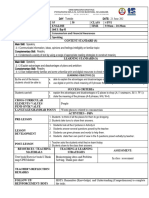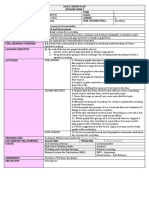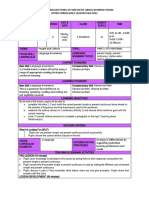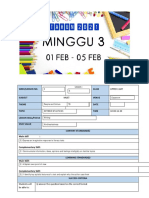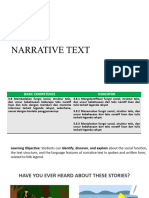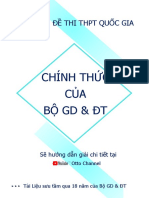0 ratings0% found this document useful (0 votes)
30 viewsForm 1 English Lesson Plan Ts25: Access To Bilingual Dictionaries Suitable For A2 Learners
Form 1 English Lesson Plan Ts25: Access To Bilingual Dictionaries Suitable For A2 Learners
Uploaded by
Aries QiqiThis document contains an English lesson plan for Form 1 students. The lesson is on the topic of money and involves several speaking, listening, and vocabulary-building activities. In the first activity, students introduce themselves to classmates and share personal details. They then work in groups to represent letters spelling the word "money" with their bodies. In the second activity, students listen to a short story called "You Cannot Steal the Moon" and make predictions about the plot before retelling the story using provided prompts. The lesson aims to improve students' speaking, listening, and understanding of vocabulary related to money and personal finances.
Copyright:
© All Rights Reserved
Available Formats
Download as DOCX, PDF, TXT or read online from Scribd
Form 1 English Lesson Plan Ts25: Access To Bilingual Dictionaries Suitable For A2 Learners
Form 1 English Lesson Plan Ts25: Access To Bilingual Dictionaries Suitable For A2 Learners
Uploaded by
Aries Qiqi0 ratings0% found this document useful (0 votes)
30 views3 pagesThis document contains an English lesson plan for Form 1 students. The lesson is on the topic of money and involves several speaking, listening, and vocabulary-building activities. In the first activity, students introduce themselves to classmates and share personal details. They then work in groups to represent letters spelling the word "money" with their bodies. In the second activity, students listen to a short story called "You Cannot Steal the Moon" and make predictions about the plot before retelling the story using provided prompts. The lesson aims to improve students' speaking, listening, and understanding of vocabulary related to money and personal finances.
Original Title
F1~W3
Copyright
© © All Rights Reserved
Available Formats
DOCX, PDF, TXT or read online from Scribd
Share this document
Did you find this document useful?
Is this content inappropriate?
This document contains an English lesson plan for Form 1 students. The lesson is on the topic of money and involves several speaking, listening, and vocabulary-building activities. In the first activity, students introduce themselves to classmates and share personal details. They then work in groups to represent letters spelling the word "money" with their bodies. In the second activity, students listen to a short story called "You Cannot Steal the Moon" and make predictions about the plot before retelling the story using provided prompts. The lesson aims to improve students' speaking, listening, and understanding of vocabulary related to money and personal finances.
Copyright:
© All Rights Reserved
Available Formats
Download as DOCX, PDF, TXT or read online from Scribd
Download as docx, pdf, or txt
0 ratings0% found this document useful (0 votes)
30 views3 pagesForm 1 English Lesson Plan Ts25: Access To Bilingual Dictionaries Suitable For A2 Learners
Form 1 English Lesson Plan Ts25: Access To Bilingual Dictionaries Suitable For A2 Learners
Uploaded by
Aries QiqiThis document contains an English lesson plan for Form 1 students. The lesson is on the topic of money and involves several speaking, listening, and vocabulary-building activities. In the first activity, students introduce themselves to classmates and share personal details. They then work in groups to represent letters spelling the word "money" with their bodies. In the second activity, students listen to a short story called "You Cannot Steal the Moon" and make predictions about the plot before retelling the story using provided prompts. The lesson aims to improve students' speaking, listening, and understanding of vocabulary related to money and personal finances.
Copyright:
© All Rights Reserved
Available Formats
Download as DOCX, PDF, TXT or read online from Scribd
Download as docx, pdf, or txt
You are on page 1of 3
FORM 1 ENGLISH LESSON PLAN TS25
WEEK/LESSON NO. LESSON 1 (Non-Textbook-Based) FORM 1C
SUBJECT English DATE / DAY 5.4.2022 Tuesday
UNIT 1 TIME 700-800
TOPIC Money Duration 1 Hour
THEME Consumerism and Financial Awareness
MAIN SKILL Speaking CROSS-CURRICULAR ELEMENTS Financial Education
21ST CENTURY LEARNING Brainstorming Vocabulary related to the topic of
TECHNIQUE(S) LANGUAGE/GRAMMAR FOCUS: money
CONTENT STANDARD(S)
Main: Complementary:
2.1 Communicate information, ideas, opinions and feelings 3.1 Understand a variety of texts by using a range of appropriate
intelligibly on familiar topics reading strategies to construct meaning
LEARNING STANDARD(S)
Main: Complementary:
2.1.1 Ask about and give detailed information about themselves 3.1.4 Use with some support familiar print and digital resources
and others to check meaning
LEARNING OBJECTIVE(S)
By the end of the lesson, pupils should be able to:
Introduce themselves by including at least three personal information.
Think of five ways to make money.
Access to bilingual dictionaries suitable
FORMATIVE ASSESSMENT TECHNIQUE(S Strategic Questioning MATERIAL(S)
for A2 learners
ACTIVITIES
Greet pupils and explain that in this lesson, they’ll get to know each other a little, and will practise speaking, listening
PRE-LESSON and using dictionaries about a topic which they’ll be studying over the next 5 lessons.
Tell them they’ll find out the topic later.
1)
Introduce yourself. Tell pupils a little about your family, something you like and why, and something you don’t like and
why.
Tell pupils that you want them to introduce themselves to each other in small groups, and that they will need to
remember what their classmates tell them, as they’ll report this information to other classmates.
Divide pupils into groups of 3, and ask them to tell each other about their family, something they like and why, and
something they don’t like and why.
2)
Create new groups of 3 and ask pupils to tell their new groups about themselves and the classmates in the previous
LESSON groups.
DEVELOPMENT Ask a few pupils to tell you one interesting thing they learned about a classmate.
Divide pupils into groups of 5 or 6 and explain that the topic of the lesson is now changing. Tell pupils that you’ll say 5
letters of the alphabet, and that the group must make this letter together in any way they choose, so that their group
represents the letter. E.g. if you say C, they could stand in a semi-circle.
Say the letters M-O-N-E-Y pausing after each letter, so that groups have time to make the letter.
Elicit from the class the word they’ve made (Money).
3)
Ask pupils to work in pairs and think of 5 ways or more people can get money (e.g. find it on the street): tell them that
they can use dictionaries to find and check words if necessary.
Elicit suggestions on the board. (Possibilities include find money, earn it, steal it, inherit it, win it, borrow it, beg for it)
Ask pupils to put these ways of getting money in order from most common to least common: pupils do this
POST-LESSON individually.
Then share answers as a whole class.
By amount of teacher’s support:
Low-proficiency pupils
DIFFERENTIATIO
- pupils complete the tasks(s) with teacher’s guidance
N High-proficiency pupils
- pupils complete the tasks(s) on their own
_____ out of ______ pupils achieved the learning objectives.
TEACHER’S
_____ pupils were given remedial treatment.
REFLECTION
FORM 1 ENGLISH LESSON PLAN TS25
WEEK/LESSON NO. LESSON 2 (Non-Textbook-Based) FORM 1C
DATE /
SUBJECT English 7.4.2022 Thursday
DAY
UNIT 1 TIME 1030-1130
TOPIC Money Duration
THEME Consumerism and Financial Awareness
MAIN SKILL Listening CROSS-CURRICULAR ELEMENTS Financial Education
21ST CENTURY LEARNING Brainstorming Past Simple Verbs
TECHNIQUE(S) LANGUAGE/GRAMMAR FOCUS:
CONTENT STANDARD(S)
Main: Complementary:
1.1 Understand meaning in a 2.4 Communicate appropriately to a small or large group on familiar topics
variety of familiar contexts
LEARNING STANDARD(S)
Main: Complementary:
1.1.6 Understand with support 2.4.1 Narrate short stories, events and experiences
longer simple narratives on a
wide range of familiar topics
LEARNING OBJECTIVE(S)
By the end of the lesson, pupils should be able to:
Listen to a short story and predict the events in the story then compare the predictions with the real events.
Listen to a short story and retell the story to a friend.
Copy of the story: You Cannot Steal
The Moon and story prompts on the
FORMATIVE ASSESSMENT TECHNIQUE(S Strategic Questioning MATERIAL(S)
pages following this lesson outline.
https://anyflip.com/lnvbl/svgh/basic
ACTIVITIES
Draw stick figures of 2 men, a small hut (teach or check this word if necessary) and the moon on the board. You can use
pictures instead if you prefer.
PRE-LESSON Tell pupils that you will tell them a story and ask them to predict the connection between the men, the hut and the
moon.
Elicit suggestions from the whole class and write them briefly on the board.
1)
Tell pupils the story ‘You Cannot Steal the Moon’.
Ask them to compare their predictions with real connection in the story briefly in pairs and then as a whole class.
Now ask pupils to listen again to the story and to be ready to tell you some of the details of the story.
LESSON Tell the story again and elicit some of the key details.
DEVELOPMENT Tell pupils that you’ll ask them to retell the story together.
2)
Hand out the story prompts and ask pupils to use them to tell the story together in pairs or small groups.
Tell the story once more to help pupils while they are working with the prompts.
Elicit the story, line by line, as a whole class activity.
Ask pupils what the final part of the story means and elicit their suggestions.
POST-LESSON Hand out the story so that pupils can check their work.
By amount of teacher’s support:
Low-proficiency pupils
DIFFERENTIATIO
- pupils complete the tasks(s) with teacher’s guidance
N High-proficiency pupils
- pupils complete the tasks(s) on their own
_____ out of ______ pupils achieved the learning objectives.
TEACHER’S
_____ pupils were given remedial treatment.
REFLECTION
FORM 1 ENGLISH LESSON PLAN TS25
WEEK/LESSON NO. LESSON 3 (Non-Textbook-Based) FORM 1C
SUBJECT English DATE / DAY 8.4.2022 Friday
UNIT 1 TIME 930-1000
TOPIC Money Duration 30 minutes
THEME Consumerism and Financial Awareness
MAIN SKILL Reading CROSS-CURRICULAR ELEMENTS Financial Education
21ST CENTURY LEARNING Brainstorming Vocabulary related to the topic of
TECHNIQUE(S) LANGUAGE/GRAMMAR FOCUS: money
CONTENT STANDARD(S)
Main: Complementary:
3.1 Understand a variety of texts by using a range of appropriate 3.1 Understand a variety of texts by using a range of appropriate
reading strategies to construct meaning reading strategies to construct meaning
LEARNING STANDARD(S)
Main: Complementary:
3.1.2 Understand specific details and information in simple 3.1.3 Guess the meaning of unfamiliar words from clues
longer texts provided by other known words and by context
LEARNING OBJECTIVE(S)
By the end of the lesson, pupils should be able to:
Read a short story and complete table based using the information from the story.
Read a short story and guess what/who the pronouns refer to.
Candy’s shopping trip worksheet.
Answers are on the page following the
FORMATIVE ASSESSMENT TECHNIQUE(S Strategic Questioning MATERIAL(S)
worksheets.
https://anyflip.com/lnvbl/svgh/basic
ACTIVITIES
Give pupils the text on Candy’s shopping trip.
PRE-LESSON Ask them to cover or fold them so that they can see only Candy.
Elicit suggestions from the whole class in response to the question above the picture of Candy.
1)
Ask pupils to uncover or unfold the text, to read it, and to answer questions 1 and 2.
Check the answers with the whole class.
Tell pupils that they’ll now focus on how language is used in the text.
Focus briefly on coordinating conjunctions as a whole class. Give an example, and then ask pupils to identify other
LESSON examples, and to explain what they link. Pupils can use L1 if necessary, as the main focus here is on understanding and
DEVELOPMENT learning, not on language use.
Give an example of a reference pronoun and what it refers to.
2)
Divide the class into 2. Tell pupils in the one half to circle reference pronouns in paragraphs 1-3 of the text and to be
ready to say who or what the pronouns refer to. Tell pupils in the other half to do the same for paragraphs 4-6.
Elicit feedback: if time is short, elicit just a few examples, so that you leave time for stage 10.
Briefly ask pupils to tell you the skills and language focus for the lesson.
POST-LESSON Ask pupils whether they think it was a good idea to spend the money in this way.
By amount of teacher’s support:
Low-proficiency pupils
DIFFERENTIATIO
- pupils complete the tasks(s) with teacher’s guidance
N High-proficiency pupils
- pupils complete the tasks(s) on their own
_____ out of ______ pupils achieved the learning objectives.
TEACHER’S
_____ pupils were given remedial treatment.
REFLECTION
You might also like
- Minggu 2 Eng Remove ClassDocument6 pagesMinggu 2 Eng Remove ClassIzzatul Fahimah Yahya100% (5)
- English Language Panel of SMK Dato' Abdul Rahman Andak Daily Lesson Plan 2019Document2 pagesEnglish Language Panel of SMK Dato' Abdul Rahman Andak Daily Lesson Plan 2019Aimie Syairah100% (1)
- QuestionsDocument13 pagesQuestionscl100% (1)
- Week 5 Form1Document6 pagesWeek 5 Form1shaNo ratings yet
- Daily Lesson PlanDocument1 pageDaily Lesson PlanapplesecretgurlzNo ratings yet
- Daily Lesson PlanDocument1 pageDaily Lesson PlanapplesecretgurlzNo ratings yet
- Week 7 Form 1Document4 pagesWeek 7 Form 1shaNo ratings yet
- 4.4 (Mon)Document4 pages4.4 (Mon)Siti AthirahNo ratings yet
- 1 JanDocument2 pages1 Janhanafiza0% (1)
- Form 1 Lesson 1 SpeakingDocument2 pagesForm 1 Lesson 1 SpeakingBranz DenzNo ratings yet
- Lesson 14 ReadingDocument2 pagesLesson 14 ReadingAnita Shekeran AaksharanNo ratings yet
- CZD WK4 (20jan 22jan)Document14 pagesCZD WK4 (20jan 22jan)chezdinNo ratings yet
- 5 December - 9 DecemberDocument10 pages5 December - 9 DecemberHarryMartinNo ratings yet
- Form 1 English Lesson Plan Ts25: Access To Bilingual Dictionaries Suitable For A2 LearnersDocument3 pagesForm 1 English Lesson Plan Ts25: Access To Bilingual Dictionaries Suitable For A2 LearnersAries QiqiNo ratings yet
- Week 1 Day 2 1 Jazari (L1)Document3 pagesWeek 1 Day 2 1 Jazari (L1)Sui Yang NguiNo ratings yet
- 31 October - 4 NovemberDocument15 pages31 October - 4 NovemberHarryMartinNo ratings yet
- CZD WK5 (29jan 31jan)Document14 pagesCZD WK5 (29jan 31jan)chezdinNo ratings yet
- WEEK 12 Lesson 27 ReadingDocument2 pagesWEEK 12 Lesson 27 Readinghasimah5768No ratings yet
- Teaching & Learning Activities: Application Evaluation Analysis CreationDocument3 pagesTeaching & Learning Activities: Application Evaluation Analysis Creationizti_azrah4981No ratings yet
- 5 December - 9 DecemberDocument19 pages5 December - 9 DecemberHarryMartinNo ratings yet
- Lesson 83 ReadingDocument2 pagesLesson 83 ReadingAnabella BrightNo ratings yet
- 27.3.22 (Sun)Document7 pages27.3.22 (Sun)Siti AthirahNo ratings yet
- English Language Panel of Sma (Arab Annajah) Form 4 English Language Daily Lesson Plan 2020Document2 pagesEnglish Language Panel of Sma (Arab Annajah) Form 4 English Language Daily Lesson Plan 2020SMA ANNAJAHNo ratings yet
- 25 April - 29 AprilDocument16 pages25 April - 29 AprilHarryMartinNo ratings yet
- Lesson 4 SpeakingDocument2 pagesLesson 4 Speakingwan mohd hafiz wan aliNo ratings yet
- Lesson 69 ReadingDocument2 pagesLesson 69 ReadingMohd HafidzNo ratings yet
- Lesson 1Document2 pagesLesson 1Spm Ppd BeaufortNo ratings yet
- 18 April - 22 AprilDocument21 pages18 April - 22 AprilHarryMartinNo ratings yet
- Lesson 4Document1 pageLesson 4Leo DingNo ratings yet
- WEEK9 RPH f4 f5 EnglishDocument7 pagesWEEK9 RPH f4 f5 EnglishMohd Azizul KhairuddinNo ratings yet
- RPH Week11 English F4 F5Document7 pagesRPH Week11 English F4 F5Mohd Azizul KhairuddinNo ratings yet
- English Language Panel of SMK Seri Pinang Daily Lesson Plan 2019Document2 pagesEnglish Language Panel of SMK Seri Pinang Daily Lesson Plan 2019Siti AthirahNo ratings yet
- Lesson 95 ReadingDocument2 pagesLesson 95 ReadingKALAI SELVI A/P CHENDERAN MoeNo ratings yet
- English Language Panel of SMK Dato' Abdul Rahman Yassin Upper Forms Daily Lesson Plan 2022Document4 pagesEnglish Language Panel of SMK Dato' Abdul Rahman Yassin Upper Forms Daily Lesson Plan 2022HAZIRA BINTI ROMAINOR A. SHUKOR MoeNo ratings yet
- F1 Lesson 1-6 NTBDocument6 pagesF1 Lesson 1-6 NTBSwee ZsuanNo ratings yet
- Mata Pelajaran Kelas Mingg U Tarikh Hari Masa: Bahasa Inggeris 5 Delima 40 Wednesday 7.00-9.00 Pagi (5 Delima 2020)Document10 pagesMata Pelajaran Kelas Mingg U Tarikh Hari Masa: Bahasa Inggeris 5 Delima 40 Wednesday 7.00-9.00 Pagi (5 Delima 2020)Suziewati Mat YaakupNo ratings yet
- Week 4Document11 pagesWeek 4Firdaus AbuNo ratings yet
- Cefr Form 1Document2 pagesCefr Form 1fatihahNo ratings yet
- Contoh Lesson Plan Bahasa Inggeris Cefr 2Document15 pagesContoh Lesson Plan Bahasa Inggeris Cefr 2NUR HAFIZA BINTI BANI MoeNo ratings yet
- Lesson 1 ReadingDocument2 pagesLesson 1 ReadingSharK HABIBNo ratings yet
- Daily Lesson Plan ReadingDocument1 pageDaily Lesson Plan ReadingSITI FARIDAH BINTI HJ. ALI MoeNo ratings yet
- RPH Week13 English F4 F5Document7 pagesRPH Week13 English F4 F5Mohd Azizul KhairuddinNo ratings yet
- Daily Lesson Plan: Main Skill Speaking 2.1Document2 pagesDaily Lesson Plan: Main Skill Speaking 2.1Noor MashitahNo ratings yet
- Unit 1 What Do You LikeDocument31 pagesUnit 1 What Do You LikeFarizul ZainalNo ratings yet
- 1 Oly 14 SEPT ESSAYDocument5 pages1 Oly 14 SEPT ESSAYg-14410888No ratings yet
- Lesson Plan Form 1Document1 pageLesson Plan Form 1nikfakrulNo ratings yet
- Daily Lesson Plan FM 1, FM 2Document2 pagesDaily Lesson Plan FM 1, FM 2Yusnita YusofNo ratings yet
- LESSON PLAN FOR FORM 1 5 AprilDocument2 pagesLESSON PLAN FOR FORM 1 5 AprilNur Nabila Natasya RazifNo ratings yet
- Mon 4.4Document4 pagesMon 4.4HAZIRA BINTI ROMAINOR A. SHUKOR MoeNo ratings yet
- Minutes: Financial EducationDocument7 pagesMinutes: Financial Educationtenang10No ratings yet
- 23 May - 27 MayDocument20 pages23 May - 27 MayHarryMartin100% (1)
- Lesson 104 SpeakingDocument2 pagesLesson 104 SpeakingDayang Nur Asilah SuhanaNo ratings yet
- Form 3 Cefr Lesson PlanDocument2 pagesForm 3 Cefr Lesson PlanSiti Umairah100% (2)
- Daily Lesson Plan Ts25: Teaching and Learning StrategiesDocument2 pagesDaily Lesson Plan Ts25: Teaching and Learning StrategieslizandrewNo ratings yet
- Lesson Plan Form 4Document2 pagesLesson Plan Form 4nikfakrulNo ratings yet
- 1c Thursdsay (Recovered)Document1 page1c Thursdsay (Recovered)Jesus Therese ThilagahNo ratings yet
- Week 2Document29 pagesWeek 2Firdaus AbuNo ratings yet
- 34Document13 pages34Suziewati Mat YaakupNo ratings yet
- Lesson: Upper 6 Art: Week/Lesson No. ClassDocument16 pagesLesson: Upper 6 Art: Week/Lesson No. ClassSuziewati Mat YaakupNo ratings yet
- Common Core Snapshot: Administrator's Guide to the Common CoreFrom EverandCommon Core Snapshot: Administrator's Guide to the Common CoreNo ratings yet
- Lesson 5Document1 pageLesson 5Aries QiqiNo ratings yet
- Form 3 English Lesson Plan Ts25: 21 Century Learning Technique (S)Document2 pagesForm 3 English Lesson Plan Ts25: 21 Century Learning Technique (S)Aries QiqiNo ratings yet
- Lesson 4Document1 pageLesson 4Aries QiqiNo ratings yet
- Form 2 English Lesson Plan Ts25: 21 Century Learning Technique (S)Document2 pagesForm 2 English Lesson Plan Ts25: 21 Century Learning Technique (S)Aries QiqiNo ratings yet
- Form 3 English Lesson Plan Ts25: Formative Assessment Technique (S)Document4 pagesForm 3 English Lesson Plan Ts25: Formative Assessment Technique (S)Aries QiqiNo ratings yet
- Form 2 English Lesson Plan Ts25: Image Related To RecyclingDocument3 pagesForm 2 English Lesson Plan Ts25: Image Related To RecyclingAries QiqiNo ratings yet
- Form 1 English Lesson Plan Ts25: Access To Bilingual Dictionaries Suitable For A2 LearnersDocument3 pagesForm 1 English Lesson Plan Ts25: Access To Bilingual Dictionaries Suitable For A2 LearnersAries QiqiNo ratings yet
- Summary of Scheme of Work Form 3 English 2022Document5 pagesSummary of Scheme of Work Form 3 English 2022Aries QiqiNo ratings yet
- Closest1 LATIHAN PrintDocument28 pagesClosest1 LATIHAN PrintAries QiqiNo ratings yet
- No Blacken Your Answer No Write Your Answer: Student'S Answer SheetDocument2 pagesNo Blacken Your Answer No Write Your Answer: Student'S Answer SheetAries QiqiNo ratings yet
- 12 Clase-11 Separata Past-Ci-Industr - 2020Document5 pages12 Clase-11 Separata Past-Ci-Industr - 2020Zulema Soto VelasquezNo ratings yet
- One-Word Compound Nouns (Closed Forms)Document2 pagesOne-Word Compound Nouns (Closed Forms)vo phan nghiemNo ratings yet
- Annotation of Antonio Morga's Sucesos de Las Islas Filipinas (Anotasyon Sa Aklat Ni Morga)Document18 pagesAnnotation of Antonio Morga's Sucesos de Las Islas Filipinas (Anotasyon Sa Aklat Ni Morga)John DavidNo ratings yet
- U2 - SpeakingDocument4 pagesU2 - SpeakingNguyễn Kim KhánhNo ratings yet
- Iz WSWAPL101 AkahowtojugglefrogsDocument23 pagesIz WSWAPL101 AkahowtojugglefrogsSergio CalvoNo ratings yet
- Workbook3 Answer KeyDocument40 pagesWorkbook3 Answer KeygiangNo ratings yet
- zb1) zb4)Document7 pageszb1) zb4)이수연No ratings yet
- English Is Cool Course Book 3 - PreviewDocument20 pagesEnglish Is Cool Course Book 3 - PreviewBurak AksuNo ratings yet
- HANDOUTS PurposiveDocument2 pagesHANDOUTS Purposivejulianna102404No ratings yet
- Holiday Hwgrade 10Document15 pagesHoliday Hwgrade 10Sahasra VarmaNo ratings yet
- InglishDocument5 pagesInglishuwu :vNo ratings yet
- Exetastai 2Document15 pagesExetastai 2Soner özmenNo ratings yet
- Triptico InglesDocument2 pagesTriptico InglesjoannaccernaNo ratings yet
- Narrative Text PowerPoint PresentationDocument10 pagesNarrative Text PowerPoint Presentationresiden bnnpsumutNo ratings yet
- Chapter 9 (Semantics)Document42 pagesChapter 9 (Semantics)nooraNo ratings yet
- 1 BAC Self Made TicketDocument151 pages1 BAC Self Made TicketHassan Saadaoui100% (1)
- Otto Channel - 31 Đề Thi Chính Thức Của Bộ GD&ĐTDocument173 pagesOtto Channel - 31 Đề Thi Chính Thức Của Bộ GD&ĐTĐình KhánhNo ratings yet
- Relicts of Mythological Consciousness in The Linguistic WorldviewDocument10 pagesRelicts of Mythological Consciousness in The Linguistic WorldviewAcademic JournalNo ratings yet
- 08 Mizo MilDocument6 pages08 Mizo MilPascal ChhakchhuakNo ratings yet
- 2012 History of Art - TextilesDocument2 pages2012 History of Art - TextilesSOPHIA POLYTECHNIC LIBRARYNo ratings yet
- Module 28Document12 pagesModule 28saanvirao816No ratings yet
- Benny The Irish Polyglot PDFDocument6 pagesBenny The Irish Polyglot PDFErikaNo ratings yet
- SSRN Id4399406Document17 pagesSSRN Id4399406Diego ManzurNo ratings yet
- PrepositionsPrepositionalPhrasesWorksheetsGrammarPracticeActivity-1Document6 pagesPrepositionsPrepositionalPhrasesWorksheetsGrammarPracticeActivity-1vaishnaviNo ratings yet
- BA English Studies (Language)Document2 pagesBA English Studies (Language)Si OneilNo ratings yet
- Irish FamiliesDocument260 pagesIrish Familiestokalulu8859No ratings yet
- Clases de Ingles Cepre 2Document18 pagesClases de Ingles Cepre 2Kath100% (1)
- Cor 001 Sas-5Document6 pagesCor 001 Sas-5hhhdhkhkhkNo ratings yet
- Business CommunicationDocument25 pagesBusiness CommunicationAditya KumarNo ratings yet









































